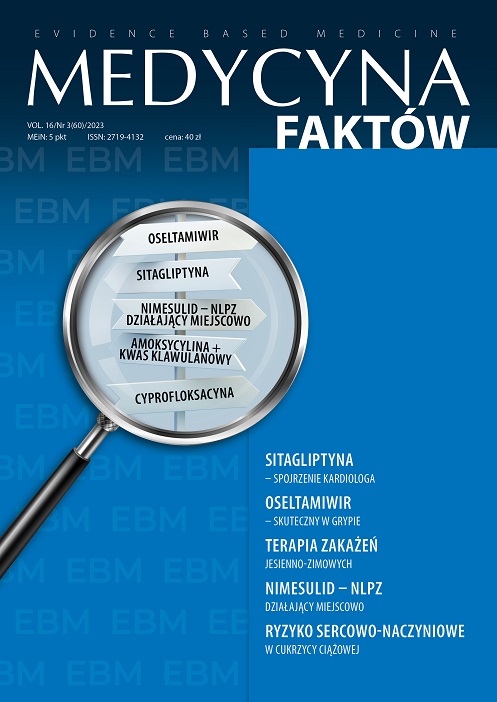Korzyści z zastosowania telmisartanu Artykuł przeglądowy
##plugins.themes.bootstrap3.article.main##
Abstrakt
Nadciśnienie tętnicze jest schorzeniem cywilizacyjnym szeroko rozpowszechnionym na całym świecie. Prowadzi do groźnych powikłań narządowych, a samo nadciśnienie i jego powikłania stanowią najczęstszą przyczynę hospitalizacji oraz zgonów. Zgodnie z zaleceniami Europejskiego Towarzystwa Nadciśnienia Tętniczego antagoniści receptora angiotensyny II należą do głównych grup leków wykorzystywanych w terapii nadciśnienia tętniczego.
Telmisartan jest skutecznym i dobrze tolerowanym lekiem hipotensyjnym, wykazującym szereg korzyści klinicznych. Cechuje się wyjątkowym profilem farmakokinetycznym w porównaniu z innymi sartanami. Ponadto jako jedyny lek z tej grupy ma rejestrację do stosowania w profilaktyce incydentów naczyniowo-sercowych u pacjentów z grup podwyższonego ryzyka sercowo-naczyniowego. Telmisartan stanowi ważną alternatywę dla inhibitorów konwertazy angiotensyny, z udowodnioną, podobną skutecznością przy niższym odsetku działań niepożądanych.
##plugins.themes.bootstrap3.article.details##
Copyright © by Medical Education. All rights reserved.
Bibliografia
2. Nadciśnienie tętnicze. Raport NFZ z 17.05.2019 r.
3. 2018 ESC/ESH Guidelines for the management of arterial hypertension.
4. Szymański FM. Telmisartan ? skuteczny lek w zapobieganiu i leczeniu chorób układu sercowo-naczyniowego. Kardiol Pol. 2014; 72(5): 65-76.
5. Dziwura J, Widecka K. Skuteczna prewencja incydentów sercowo-naczyniowych u pacjentów z grupy wysokiego ryzyka ? nowe wskazanie dla telmisartanu. Nadciśnienie Tętnicze. 2010; 14(4): 332-43.
6. Fitchett D. Results of the ONTARGET and TRANSCEND studies: an update and discussion. Vasc Health Risk Manag. 2009; 5: 21-9.
7. Barylski M, Banach M, Szadkowska I et al. Antagoniści receptora angiotensyny II w terapii nadciśnienia tętniczego u osób w wieku podeszłym. Geriatria. 2008; 2: 45-54.
8. Wienen W, Hauel N, Van Meel JCA et al. Pharmacological characterization of the novel nonpeptide angiotensin II receptor antagonist, BIBR 277. Br J Pharmacol. 1993; 110: 245-52.
9. Neutel JM. Ambulatory blood pressure monitoring to assess the comparative efficacy and duration of action of a novel new angiotensin II receptor blocker ? telmisartan. Blood Press Suppl. 2001; 1: 27-32.
10. Mancia G, Kreutz R, Bruntström M. 2023 ESH Guidelines for the management of arterial hypertension The Task Force for the management of arterial hypertension of the European Society of Hypertension Endorsed by the European Renal Association (ERA) and the International Society of Hypertension (ISH). J Hypertens. 2023. http://doi.org/10.1097/HJH.0000000000003480.
11. Takagi H, Niwa M, Mizuno Y. Telmisartan as a metabolic sartan: The first meta-analysis of randomized controlled trials in metabolic syndrome. JASH. 2013; 7(3): 229-35.
12. Schmieder RE, Delles C, Mimran A. Impact of Telmisartan Versus Ramipril on Renal Endothelial Function in Patients With Hypertension and Type 2 Diabetes. Diabetes Care. 2007; 30(6): 1351-6.
13. Lewandowska A, Kręgielska-Narożna M, Bogdański P. Ocena sztywności naczyń jako element analizy ryzyka sercowo-naczyniowego. Forum Zaburzeń Metabolicznych. 2017; 8(4): 161-70.
14. Asmar R, Gosse P, Topouchian J. Effects of telmisartan on arterial stiffness in Type 2 diabetes patients with essential hypertension. J Renin Angiotensin Aldosterone Syst. 2002; 3(3): 176-80.
15. Ladino M, Hernandez Schulman I. Renovascular and renoprotective properties of telmisartan: clinical utility. Int J Nephrol Renovasc Dis. 2010; 3: 33-8.
16. Barnett AH. Preventing renal complications in diabetic patients: the Diabetics Exposed to Telmisartan And enalaprIL (DETAIL) study. Acta Diabetologica. 2005; 42: 42-9.
17. Makino H, Haneda M, Babazono T et al. Microalbuminuria reduction with telmisartan in normotensive and hypertensive Japanese patients with type 2 diabetes: a posthoc analysis of The Incipient to Overt: Angiotensin II Blocker, Telmisartan, Investigation on Type 2 Diabetic Nephropathy (INNOVATION) study. Hypertens Res. 2008; 31: 657-64.
18. Parker AB, Azevedo R, Baird MG. ARCTIC: assessment of haemodynamic response in patients with congestive heart failure to telmisartan: a multicentre dose-ranging study in Canada. Am Heart J. 1999; 138(5): 843-8.
19. Blessing E, Preusch M, Kranzhofer R. Anti-atherosclerotic properties of telmisartan in advanced atherosclerotic lesions in apolipoprotein E deficient mice. Atherosclerosis. 2008; 199(2): 295-303.
20. Takaya T, Kawashima S, Shinohara M. Angiotensin II type 1 receptor blocker telmisartan suppresses superoxide production and reduces atherosclerotic lesion formation in apolipoprotein E-deficient mice. Atherosclerosis. 2006; 186: 402-10.
21. Barthold D, Joyce G, Wharton W et al. The association of multiple anti-hypertensive medication classes with Alzheimer?s disease incidence across sex, race, and ethnicity. PLoS One. 2018; 13(11): e0206705.
